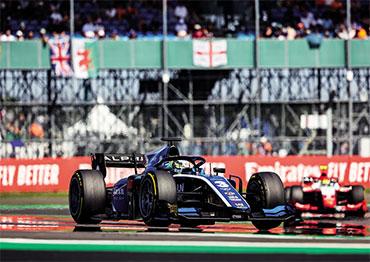Formula Racing is based on a pyramid ranking system. The most well-known categories are Formula 1, 2, 3 and 4.
On May 21, Zhou won the first sprint race of the F2 Monaco Grand Prix. In July, he won the F2 feature race at Silverstone, triumphing over Williams junior driver Dan Ticktum and fellow Alpine Academy driver Oscar Piastri. At the time, he ranked first in the F2 standings.
Zhou was overwhelmed with expectation and anxiety. He was eager to enter the F1 2022 season, but only two F1 teams still had vacancies, and 10 drivers were gunning for them.
Alfa Romeo had shown interest, but wanted see how Zhou performed during the season.
“I’ve never felt so much pressure from within or without,” Zhou said about his mindset at the time. “Even though the pressure was almost unbearable, fortunately I didn’t drop the ball.”
Zhou had his F2 debut during the 2019 season as a member of the Alpine Academy, the talent development program for the Alpine F1 team. Having taken five podiums, he finished seventh that year and was awarded the Anthoine Hubert Award for the highest-ranking rookie.
Zhou’s 2020 season was full of twists and turns. He had a clear goal to rank in the year’s top three and was confident he could win the F2 championship, but a series of mechanical failures slowed his ambitions. In the first race in Bahrain, Zhou, who led for most of the race, missed the podium after a mechanical breakdown. In the remaining races, Zhou had multiple mechanical problems and accidents. His season highlight came in the Sochi Sprint Race in Russia in September 2020, when he made history as the first Chinese driver to win an F2 race. With one win and six podiums, Zhou finished sixth for the season.
“Failing to rank in the top three last year stressed me out a lot,” Zhou said. “In the past, even though people always said I was the Chinese driver who was closest to joining F1, inside I knew that last step seemed near but was actually still quite far, until this year,” he added.
Zhou had a glorious F2 season in 2021. On March 28, he won the Feature Race of the Sakhir F2 round in Bahrain. Later he won in Monaco and at Silverstone. With a win and a second place in the final round in Abu Dhabi, Zhou cemented third place overall, behind top driver Oscar Piastri of Australia and Robert Shwartzman of Russia.
In September, Zhou had his first-ever F1 practice session at the 2021 Austrian Grand Prix. It was significant for him – he would drive the legendary racer Fernando Alonso’s A521 for one hour.
Alonso, Zhou’s idol since childhood, has helped Zhou the most over the past three years.
“That weekend, we walked to the track together. He patiently answered all of my questions and gave me lots of advice based on his own experience,” Zhou told NewsChina.
“When you get to this level, mostly it’s engineers that will help you. Professional drivers rarely volunteer to help. I was full of deep gratitude and reverence for him. A double world champion was still sincerely willing to teach and help me. Fortunately, I didn’t let him down,” he added.

 Old Version
Old Version


